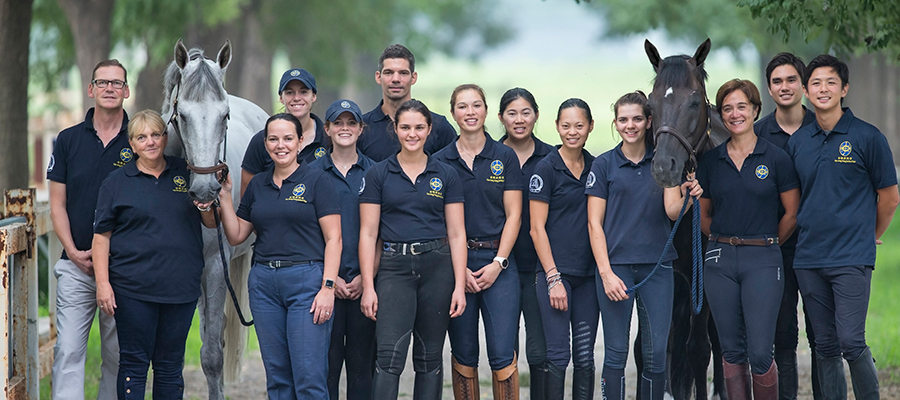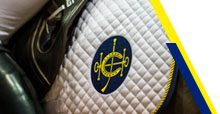

About HKJC
HKJC Equestrian Team in Tianjin
Striding on together - the HKJC and equestrian sport share the same spirit of partnership and commitment to excellence.

The 2017 Tianjin National Games Equestrian
Eight riders from the Hong Kong Jockey Club Equestrian Team will compete in the equestrian events of the Tianjin National Games, to be held at the Metropolitan Polo Club, Tianjin, China, from 29 August to 7 September 2017. It will be the first time for the Hong Kong Equestrian Team to compete in all three disciplines of the competition, namely, dressage, eventing and show jumping.
Click here for "National Games Equestrian Updates"
| Date | Events | Riders (Horses) |
|---|---|---|
| 29 August | Show Jumping - Team Competition | Kenneth Cheng (Chaccopia) |
| 31 August | Show Jumping – Individual Competition | |
| 3 September | Dressage Individual Qualifier | Jacqueline Siu (Jockey Club Connery) |
| 4 September | Dressage Individual Final | |
| 5 September | Eventing - Dressage (Team & Individual) | Annie Ho (Jockey Club Amy Lee 2) |
| 6 September | Eventing - Cross Country (Team & Individual) | |
| 7 September | Eventing - Show Jumping (Team & Individual |
Jumping Competition Format
The Show Jumping Discipline will be competing in 4 rounds. The first two rounds are Team Competitions and the last two rounds are Individual Competitions. The number of obstacles for Team Competition and Individual Competition are 12 as maximum, with 1 double, 1 triple bar and a water jump with 3.5m width. The speed is set as 350m per minute.
| Show Jumping Team Competition | Different course plans will be set for the two rounds of Team Competition against the clock. The heights of obstacles will be set from 1.35m to 1.45m, and the widths will be set from 1.40m to 1.60m (Triple bar: 1.90m). The results of top 3 riders will be accumulated as each team result; the team with less accumulated penalties over 2 rounds will get a higher ranking. In case of equality of penalties for two or more teams, the team with a faster time in the second round will get a higher ranking. |
| Show Jumping Individual Competition | The Team Competition is also the qualifier for Individual Competition. The top 20 ranking riders (including those tied for the 20th place) will obtain the qualification for Individual Competition. Different course plans will be set for two individual rounds, not against the clock. The obstacles height will be set from 1.45m to 1.55m, with a width from 1.50m to 1.70m (Triple bar: 2.00m). The ranking will be determined by the accumulated penalties in both rounds. In case of equality of penalties for the fourth place and after, the team with a faster time at the fourth round will get a higher placing. In case of equality of penalties for top 3 athletes, there will be a jump-off against the clock. The number of obstacles and difficulties will be decided at a later stage. The total penalties and time in the jump-off will decide the medal placing. |
Dressage Competition Format
Each National Olympic Committee (NOC) can enter with a maximum of four horse-rider combinations with the best three results to count for the team classification.
| Event | Test |
|---|---|
| Dressage Team/ Dressage Individual Qualifier |
FEI Prix St-Georges Test |
| Dressage Individual Round 1 | FEI Intermediate (1) Test |
| Dressage Individual Round 2 | FEI Intermediate (1) Freestyle to Music |
| Dressage Team Competition | In the Dressage Team competition, the classification will be decided by adding together the percentage scores of the three best placed athletes of each team. The team with the highest total percentage scores will be declared the winner. In the event of a tie for the first three placings, the winning team is the team whose lowest placed athlete from the three has better result. In case the teams are still tie, the team with the higher total marks/percentage of the two lowest placed athletes of the three is better placed. |
| Dressage Individual Competition | The Individual qualifier is limited to the 12 best horse-rider combinations to the Individual Final Round 1 & 2, including those tied for the 12th place. The final classification for Dressage Individual will be decided by adding together the percentage scores attained in Dressage Individual Round 1 & 2. The athlete with the highest total percentage score will be declared the winner. In the event of a tie for the placing, the athlete with the best result in Freestyle will win. Should this result be the same, the artistic mark will decide the winner. Should the artistic marks be the same, the marks for Harmony will decide the winner. |
Eventing Competition Format
Eventing will be held over three days, following by the order of Dressage, Cross-country and Jumping. The level of Dressage will be set as 2* competition (Table B), and the technical requirements for Cross-country and Jumping are based on the FEI 2* competition rules.
Eventing Team Competition
The classification will be decided by adding together the penalties of the three best placed athletes of each team. The team with the lowest total penalties will be declared the winner. The team with the second lowest total penalties will be awarded the second place, and so on. In the event of equality, the classification will be decided by the best combined highest three placing.
Eventing Individual Competition
The top 20 horse-rider combinations (including those tied for the 20th place) in the team competition will be eligible to participate in the Individual Final. Individual Final only have one round of Jumping competition, the height of obstacles will be raised 5cm higher than that of the team competition. The final classification for Eventing Individual competition is the athlete with the lowest total penalties incurred in all three tests and the individual final. The athlete with the second lowest total penalties will be awarded the second place and so on.
In the event of equality between two or more athletes, the classification will be decided by:
- The best Cross Country score including penalties for faults at obstacles and time penalties;
- If there is still equality, the classification is decided in favour of the athlete whose Cross Country time was closest to the optimum time;
- If there is still equality, the classification is decided in favour of the athlete with the best jumping score including penalties at obstacles and time penalties;
- If there is still equality, the athlete with the fastest time in the Jumping test will decide the winner;
- If there is still equality, the classification will be decided in favour of the athlete with the best percentage in the Dressage Test.


